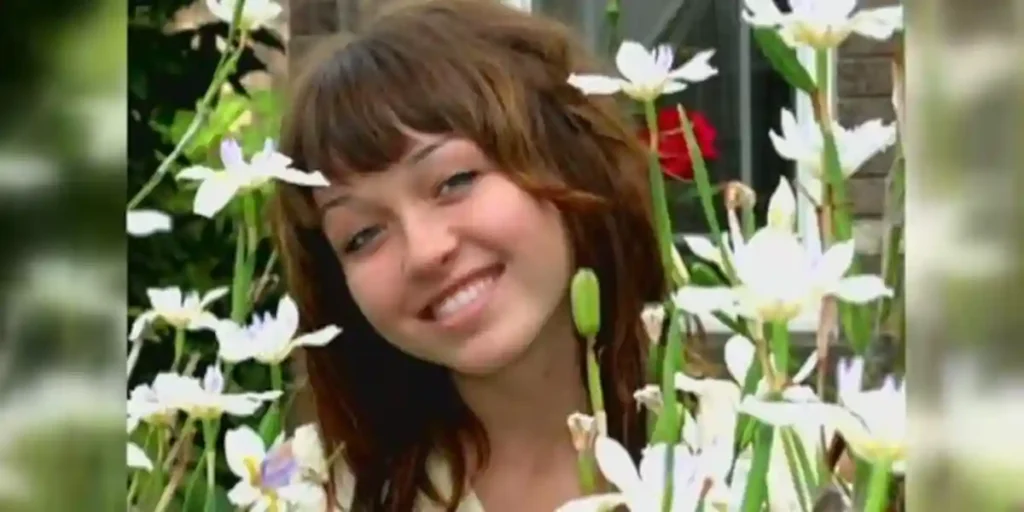Nikki Catsouras died in a car crash on October 31, 2006. She was just 18 years old. This tragic event changed her family’s life forever. But the real nightmare started after her death.
Who Was Nikki Catsouras?

Nicole “Nikki” Catsouras was born on March 4, 1988. She lived with her family in California. Nikki was the oldest of four daughters. Her parents were Christos and Lesli Catsouras.
Basic facts about Nikki:
- Born: March 4, 1988
- Died: October 31, 2006
- Age at death: 18 years old
- Family: Parents and three younger sisters
- Home: Ladera Ranch, California
The Day Everything Changed
October 31, 2006 started like any normal day. The family had lunch together at home. Christos, Nikki’s father, left for work around 1:30 PM. He said goodbye to his wife and daughters. Nikki waved at him from the couch. She made a peace sign with her fingers.
Timeline of that day:
- 1:30 PM: Christos left for work
- 1:40 PM: Nikki took her father’s car
- 2:00 PM: The crash happened
- 2:15 PM: Police arrived at the scene
About ten minutes after her father left, Nikki took the keys. She drove off in her father’s Porsche 911 Carrera. This was against family rules. Nikki was not supposed to drive that car.
The Fatal Crash

Nikki drove the Porsche at very high speed. She was going over 100 miles per hour. The car was on State Route 241 in Lake Forest, California.
At 2:00 PM, Nikki lost control of the car. The Porsche hit a concrete toll booth. The impact was massive. Nikki died right away.
Details of the Nikki Catsouras death crash:
- Location: State Route 241, Lake Forest
- Time: 2:00 PM
- Speed: Over 100 mph
- Cause: Lost control of vehicle
- Impact: Concrete toll booth structure
- Result: Death on impact
The crash was so severe that the car was destroyed. The damage was extreme. Police officers took photos of the scene. This was standard procedure for fatal accidents.
When Photos Became Public
After the Nikki Catsouras death, something terrible happened. Two police officers shared the accident photos. They sent the pictures to their friends and family. This was completely wrong and against the rules.
The photos showed Nikki’s body after the crash. The images were very graphic and disturbing. They should have stayed private. Only the police and coroner should have seen them.
How the photos spread:
- Two CHP officers shared the images
- They sent photos to friends
- People forwarded them online
- The images went viral quickly
- Hundreds of websites posted them
Within weeks, the photos were everywhere on the internet. People called them the “Porsche Girl” photos. The images spread faster than anyone could stop them.
The Family’s Nightmare Begins
Two weeks after Nikki died, Christos got a phone call. A friend asked him if he had seen the photos online. This was how the family found out about the leaked images.
The Catsouras family was shocked and horrified. They were already dealing with the loss of their daughter. Now they had to face this new trauma. The photos were on hundreds of websites.
Impact on the family:
- Constant fear of seeing the images
- Harassment from internet users
- Unable to use computers safely
- Three younger daughters traumatized
- Had to change their lifestyle completely
The family could not use the internet normally. Every search about Nikki brought up the photos. The images appeared without warning. This caused more pain every time.
People also used the photos to harass the family. They sent the pictures in emails. Some people made cruel jokes about Nikki’s death. The family received horrible messages.
Legal Fight for Justice
The Catsouras family decided to fight back. They hired lawyers and sued the California Highway Patrol (CHP). The family wanted justice for what happened to Nikki’s photos.
The lawsuit claimed several things:
- Officers violated their duty
- The photos should have stayed private
- The family suffered emotional damage
- The CHP failed to train officers properly
The case was not easy to win. California law did not protect privacy rights for dead people. The family had to prove their case in new ways.
First court decision:
- Lower court dismissed the case
- Judge said CHP had no special duty
- Family decided to appeal
- New legal arguments were needed
The Appeal and Victory
The family did not give up. They appealed to a higher court. This court looked at the case differently. The judges understood the family’s pain and suffering.
The appeals court made an important decision. They said the family did have privacy rights. The court ruled that the photos should have stayed private.
Key points from the appeal:
- Family privacy rights were recognized
- Photos should not have been shared
- Officers acted wrongly
- The case could move forward
This was a big win for the Catsouras family. It was also important for other families facing similar problems.
The Settlement
On January 30, 2012, the case was finally settled. The CHP agreed to pay the family money. The settlement was for $2.37 million.
Settlement details:
- Amount: $2.37 million
- Date: January 30, 2012
- No admission of guilt by CHP
- Family could finally move forward
The CHP said no amount of money could fix the family’s pain. This was true. But the settlement showed that what happened was wrong.
The Officers Who Shared Photos
Two CHP officers were responsible for sharing the photos. Their names were Aaron Reich and Thomas O’Donnell. Both officers faced consequences for their actions.
What happened to the officers:
- Internal investigation was conducted
- Both received disciplinary action
- Their actions violated department policy
- They caused harm to a grieving family
The officers said they shared the photos as a warning. They claimed it was to show how dangerous speeding could be. But this excuse did not work. The photos were shared for entertainment, not education.
Problems with Removing Photos
Even after winning the lawsuit, the photos stayed online. The internet makes it very hard to remove content completely. New websites kept posting the images.
Challenges in removing photos:
- Thousands of websites had them
- New sites appeared regularly
- International servers were hard to control
- Search engines kept finding them
- People kept reposting the images
The family tried many ways to get the photos removed. They contacted website owners. They asked search engines for help. Some sites removed the photos, but others did not.
Impact on Privacy Laws
The Nikki Catsouras death case changed privacy laws in California. The case created new protections for families of deceased people.
Changes in the law:
- Families now have privacy rights after death
- Police must protect sensitive materials
- Sharing such photos can lead to lawsuits
- New training requirements for officers
These changes help protect other families. If something similar happens, families have more legal options.
Lessons for Police Departments
The case taught police departments important lessons. They needed better rules about handling sensitive photos and evidence.
New policies include:
- Strict photo sharing rules
- Better officer training
- Clear consequences for violations
- Regular policy reviews
Many departments changed their procedures after this case. They wanted to prevent similar problems in the future.
How the Internet Changed
The Nikki Catsouras death case happened during the early days of social media. The internet was becoming more popular. People were sharing more content online.
The case showed several problems:
- Content spreads very quickly online
- Once posted, things are hard to remove
- People sometimes share without thinking
- Graphic content can cause real harm
Website owners started creating better policies. They began removing graphic death photos more quickly. Some sites banned such content completely.
The Family Today
The Catsouras family still lives with the effects of what happened. They moved to a new location for privacy. The three surviving daughters grew up under difficult circumstances.
Current situation:
- Family lives in undisclosed location
- They avoid using their real names online
- The photos still appear on some websites
- They continue to advocate for privacy rights
The family speaks out about internet privacy when they can. They want to help other families avoid similar problems.
Preventing Similar Cases
The Nikki Catsouras death case shows why privacy protection is important. Several steps can help prevent similar situations.
Law enforcement:
- Train officers about privacy rights
- Create clear photo sharing policies
- Monitor officer compliance
- Take swift action when rules are broken
For internet users:
- Think before sharing graphic content
- Consider how families might be affected
- Report inappropriate content when seen
- Respect the privacy of accident victims
For website owners:
- Create policies against graphic death photos
- Respond quickly to removal requests
- Use better content filtering systems
- Consider the human impact of posted content
Support for Affected Families
Families dealing with similar problems can get help. Several organizations work on privacy rights and victim support.
Available resources:
- Legal aid for privacy violations
- Counseling for traumatized families
- Technical help with content removal
- Advocacy groups for victim rights
The Catsouras family’s case made it easier for other families to get help. Their legal victory created new options for families facing similar problems.
The Lasting Impact
The Nikki Catsouras death case is still important today. It changed how we think about privacy and the internet. The case created new laws and policies.
Key changes from the case:
- Better privacy protections for families
- New rules for police photo handling
- Improved website content policies
- Greater awareness of internet harm
The case also showed how the internet can cause real harm to real people. It reminded everyone that there are humans behind the headlines and images.
Questions People Ask
Many people have questions about the Nikki Catsouras death case. Here are answers to common questions.
Why did Nikki take the car?
- She was 18 and sometimes made poor choices
- Teenagers often take risks
- She may not have understood the danger
- This was a tragic accident
Could the crash have been prevented?
- If she had driven slower, possibly
- If she had not taken the car, yes
- Road conditions were not a factor
- The speed was the main cause
Why did officers share the photos?
- They violated department policy
- They showed poor judgment
- They caused additional harm to the family
- Their actions were completely wrong
Are the photos still online?
- Some websites still have them
- The family continues removal efforts
- New laws make sharing them illegal
- Most major sites have removed them
What We Can Learn
The Nikki Catsouras death case teaches us many important lessons. These lessons can help prevent similar tragedies in the future.
Driving safety:
- Speed kills in car accidents
- Teenage drivers need better education
- Sports cars require extra caution
- Every family should discuss driving rules
Internet responsibility:
- Think before sharing sensitive content
- Consider the impact on families
- Report inappropriate material
- Respect the privacy of victims
Privacy rights:
- Families deserve protection after tragedy
- Laws can and should protect people
- Legal action can create positive change
- Privacy matters even after death
The Real Cost of the Case
The Nikki Catsouras death case cost everyone involved. The family paid with years of additional suffering. The police department paid money and reputation. Society paid by learning hard lessons about internet responsibility.
Costs to the family:
- Years of legal battles
- Ongoing emotional trauma
- Loss of normal internet use
- Constant fear of seeing the photos
Costs to law enforcement:
- $2.37 million settlement
- Damaged public trust
- Need for new training programs
- Policy changes across departments
But the case also brought positive changes. New laws protect other families. Police departments have better policies. People are more aware of internet responsibility.
Conclusion
The Nikki Catsouras death case changed internet privacy laws forever. Her family’s legal fight created new protections for grieving families. Police officers now face consequences for sharing private photos. Websites remove graphic content faster. While nothing can bring Nikki back, her family’s courage helped protect other families from similar trauma. The case proves that fighting for justice can create positive change for everyone.






